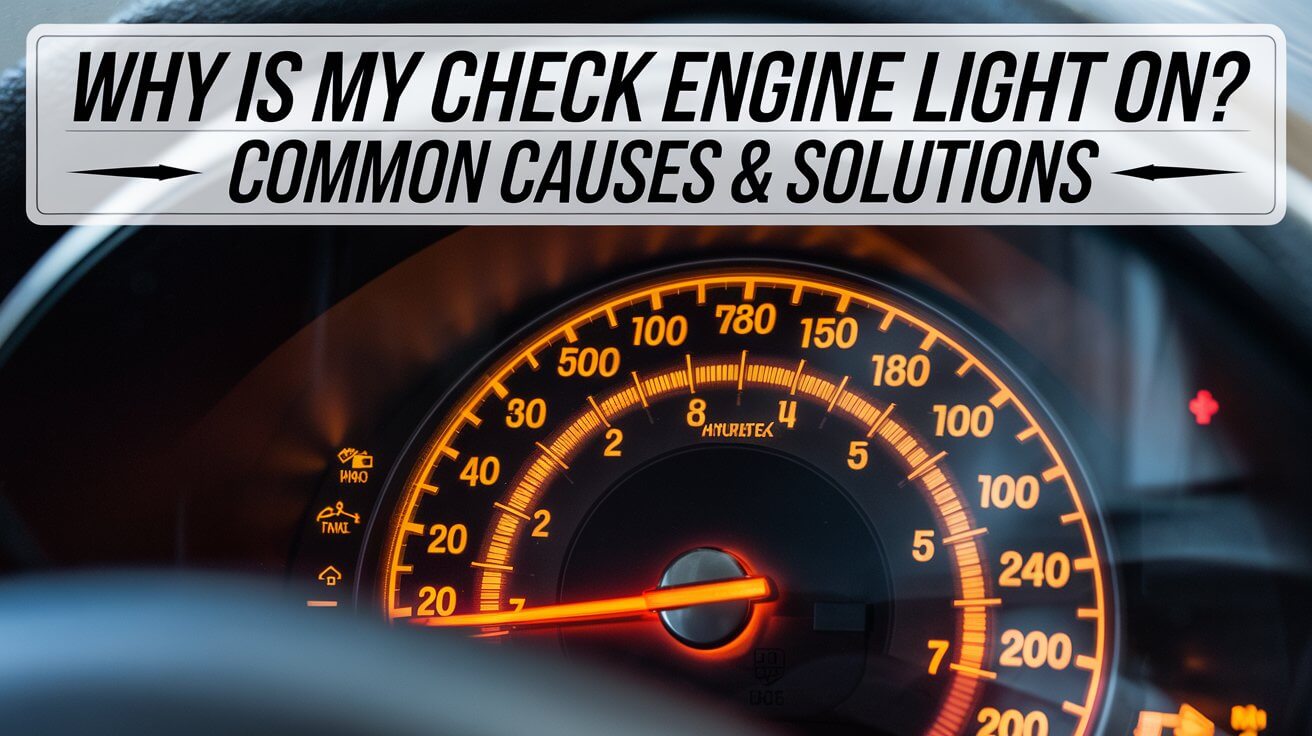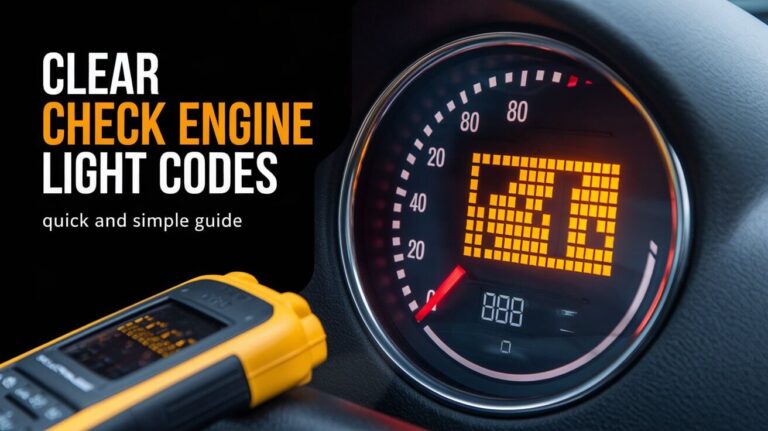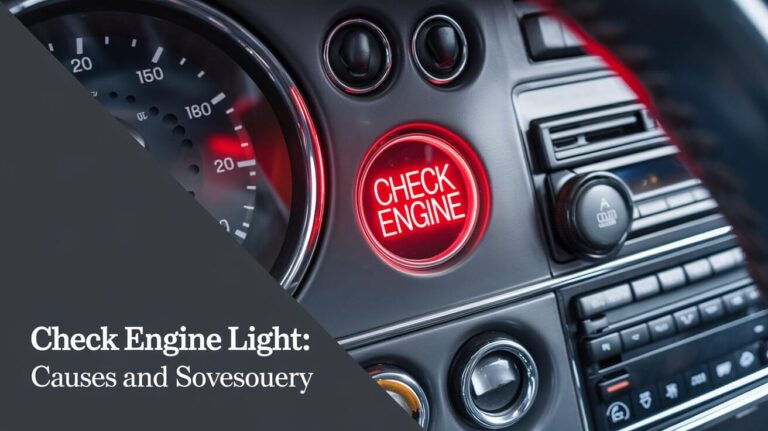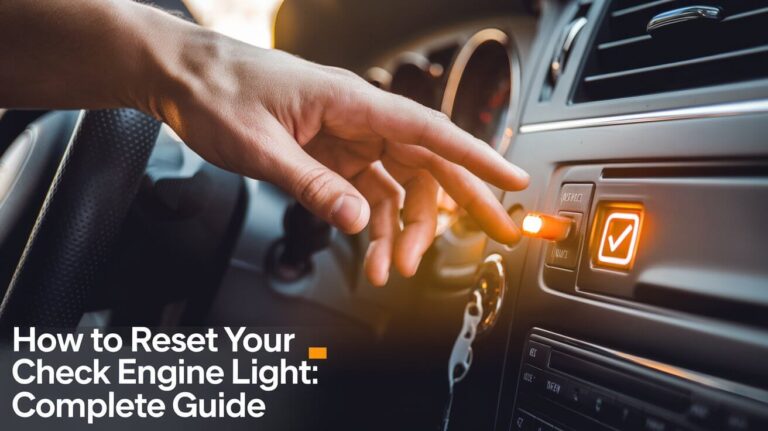Why Is My Check Engine Light On? Common Causes & Solutions

The dreaded check engine light (CEL) is something most drivers experience at some point. It can appear suddenly and cause immediate concern, but what does it really mean? The check engine light is your car’s way of telling you that something is wrong. While it could indicate a minor issue, such as a loose gas cap, it could also signal something more serious like an engine misfire or a failing catalytic converter.
In this article, we’ll dive deep into the common reasons your check engine light may come on, how to address it, and tips for preventing future problems. Whether your car is running fine or showing other symptoms, this guide will help you understand what’s going on under the hood and what steps you should take.
What Does a Check Engine Light Indicate?
When your car’s check engine light turns on, it’s part of your vehicle’s onboard diagnostics system (OBD-II). This system monitors various engine components to ensure everything is running smoothly and efficiently. The light may come on for several reasons, from something as simple as a loose gas cap to more severe issues like a failing catalytic converter or engine misfire.
There are two types of check engine lights:
- Solid Light: This usually indicates a non-urgent issue, but it should still be addressed soon. It may be related to something minor, like a faulty sensor.
- Flashing Light: A flashing light indicates a severe problem, such as an engine misfire. This should be dealt with immediately, as continued driving could damage your engine further.
Common Reasons Your Check Engine Light Is On
Loose or Faulty Gas Cap
One of the most common reasons for a check engine light is a loose or faulty gas cap. The gas cap helps maintain the pressure in your fuel system and keeps gasoline vapors from escaping into the air. If it’s not secured properly, your car’s emission system could be compromised, triggering the check engine light.
Fortunately, this is one of the easiest issues to fix. Simply tighten the cap or replace it if it’s damaged. If the light remains on after fixing the gas cap, there may be another issue that needs attention.
Failing Oxygen Sensor
Your vehicle’s oxygen sensor plays a critical role in monitoring the amount of unburnt oxygen in your exhaust. This helps the engine control its air-fuel mixture to improve performance and reduce emissions. When the sensor fails, the car can’t regulate this mixture properly, leading to reduced fuel efficiency and increased emissions.
Replacing a faulty oxygen sensor is essential to prevent further issues with the engine or exhaust system. If left unchecked, it could also damage other parts, like the catalytic converter.
Faulty Catalytic Converter
The catalytic converter is a vital component of your car’s exhaust system, responsible for reducing harmful emissions. It converts toxic gases, like carbon monoxide, into less harmful substances before they are released into the environment. Over time, the catalytic converter can become clogged or damaged, leading to poor engine performance and the check engine light turning on.
If the converter fails, your vehicle may experience reduced power and fuel efficiency, and it may even fail an emissions test. In some cases, replacing the catalytic converter is the only solution.
Mass Airflow (MAF) Sensor Issues
The mass airflow sensor measures the amount of air entering the engine and helps adjust the air-fuel mixture accordingly. A malfunctioning MAF sensor can cause poor fuel economy, rough idling, and even stalling. If the check engine light is triggered by this sensor, it might be due to a dirty or faulty MAF sensor.
Sometimes, cleaning the sensor can resolve the issue, but in other cases, it may need to be replaced.
Bad Spark Plugs or Ignition Coil Problems
The ignition system in your car relies on spark plugs and ignition coils to ignite the air-fuel mixture in the engine’s cylinders. If the spark plugs or coils are worn out or damaged, it can result in misfires, poor acceleration, and lower fuel efficiency. This is a common cause of the check engine light.
Replacing worn spark plugs or ignition coils is necessary to restore proper engine function and prevent further damage to other components.
Battery or Alternator Issues
Your car’s electrical system is powered by the battery and alternator. If either component fails, it can lead to a variety of issues, including a check engine light. Common symptoms include difficulty starting the car, dimming headlights, and electrical malfunctions.
If the light is triggered by an electrical issue, you may need to replace the battery or alternator. Addressing electrical problems promptly will prevent further complications down the road.
Less Common but Possible Causes
EVAP System Leak
The evaporative emission control system (EVAP) prevents gasoline vapors from escaping into the atmosphere. A leak in the EVAP system, often caused by a loose gas cap, can trigger the check engine light. This system plays a crucial role in reducing pollution and keeping your car environmentally friendly.
An EVAP system leak should be diagnosed and repaired by a professional to ensure your car is running clean and efficiently.
Faulty Thermostat
The thermostat controls the flow of coolant to your engine, regulating its temperature. A faulty thermostat can cause your engine to overheat, triggering the check engine light. Overheating can lead to more significant engine damage if not addressed promptly.
Replacing a faulty thermostat is a relatively simple fix that can prevent more severe engine problems.
Transmission Problems
While less common, transmission issues can sometimes trigger the check engine light. Transmission problems are usually accompanied by other symptoms, such as difficulty shifting gears, strange noises, or slipping gears.
If you suspect a transmission issue, it’s best to consult a professional mechanic for diagnosis and repair.
What To Do When the Check Engine Light Comes On
Step 1 – Check the Gas Cap
The first thing to check when the CEL comes on is the gas cap. If it’s loose or damaged, tightening or replacing it could solve the problem. After securing the cap, the light may turn off after driving for a bit. If it doesn’t, there could be another issue.
Step 2 – Scan for Diagnostic Trouble Codes (DTCs)
If tightening the gas cap doesn’t resolve the issue, the next step is to use an OBD-II scanner to read the diagnostic trouble codes (DTCs). These codes provide specific information about what triggered the check engine light. You can either buy a scanner or visit an auto shop that offers this service.
Step 3 – Investigate Symptoms
Once you have the DTCs, investigate any symptoms your vehicle is exhibiting. Is it idling rough? Is there a strange smell coming from the exhaust? These additional clues can help pinpoint the issue.
Step 4 – Seek Professional Help
If you’re unable to diagnose or fix the problem, it’s time to consult a professional mechanic. Some issues, like a faulty catalytic converter or transmission problem, require specialized tools and expertise to repair.
How to Prevent the Check Engine Light from Coming On
Regular Maintenance
One of the best ways to prevent the check engine light from coming on is to stay on top of regular maintenance. This includes routine oil changes, air filter replacements, and spark plug checks. Following your vehicle’s recommended maintenance schedule can prevent many common problems.
Addressing Minor Issues Promptly
If you notice small issues, like rough idling or unusual sounds, address them as soon as possible. Ignoring these signs can lead to more significant problems down the line, which could trigger the check engine light.
Using High-Quality Fuel
High-quality fuel can improve your engine’s performance and reduce the likelihood of triggering the check engine light. Low-quality or contaminated fuel can cause issues like clogged fuel injectors or a failing catalytic converter.
The Costs of Ignoring a Check Engine Light
Ignoring a check engine light can lead to costly repairs and even more severe damage to your vehicle. For example, driving with a faulty catalytic converter can damage your exhaust system, while ignoring a misfire can lead to engine damage. Addressing the issue as soon as the light comes on can save you time and money in the long run.
Conclusion
The check engine light is your vehicle’s way of telling you that something is wrong, but not all problems are equally serious. Whether it’s a simple fix like tightening the gas cap or a more complex issue like replacing the catalytic converter, addressing the issue promptly is essential to keeping your car running smoothly. By following the steps outlined above, you can diagnose the problem, fix it, and prevent future issues from arising.
Don’t wait for a small issue to turn into a big one. Take action when your check engine light comes on to keep your vehicle in top shape.




